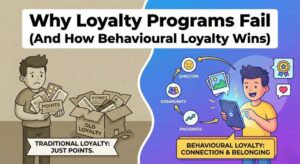In today’s competitive environment, automation is at the heart of modern customer relationship management (CRM). Brands deploy complex lifecycle journeys across email, push notifications, SMS, WhatsApp, and more to nurture customers at every stage.
But while CRM automation promises scale and efficiency, it can easily backfire when not carefully designed and managed.
Instead of delivering seamless, personalized experiences, too many automated journeys can cause confusion — for both customers and internal teams — leading to fatigue, inefficiency, and missed growth opportunities.
In this blog, we unpack the hidden costs of over-automation in CRM and offer a framework to simplify journeys for better outcomes.

Automation’s Promise vs. Reality
At its best, CRM automation helps brands respond quickly, consistently, and contextually to customer behavior.
It allows marketers to create tailored touchpoints: onboarding flows, win-back journeys, loyalty nudges, replenishment reminders, and more.
But as organizations scale their CRM programs, complexity creeps in.
Teams often add new journeys reactively — for every segment, product, or seasonal campaign — without pausing to check how these flows interact.
The result? A tangled web of automated journeys where:
- Customers may enter multiple journeys at once
- Messages overlap or contradict each other
- Teams lose track of what’s running and why
While automation can be a growth driver, unchecked complexity becomes a growth blocker.
Warning Signs of Over-Automation
How do you know when your CRM automation has crossed the line into over-engineering?
Here are some clear signals:
- Excessive message frequency:
Customers receive too many touchpoints in a short period, increasing opt-outs and unsubscribes.
- Conflicting journeys:
For example, a customer receives a win-back email even though they’ve just made a purchase and are also in a loyalty campaign.
- Declining engagement despite high automation activity:
If open, click, and conversion rates fall as journey count rises, this indicates fatigue.
- Internal confusion:
Marketing and CRM teams can’t easily answer:
“Which journeys is this customer in right now? What will they receive next?”
- Maintenance challenges:
Small changes take too long because journeys are too numerous or interconnected.
These symptoms suggest that your automation is no longer serving your customer or your business effectively.
The Hidden Costs of Over-Automation
Over-automation not only risks damaging customer relationships but also imposes real operational and financial costs:
- Customer fatigue:
Receiving redundant or irrelevant messages diminishes trust and erodes brand perception.
- Inconsistent experience:
When journeys overlap, customers may receive mixed messages or offers that don’t align with their recent behavior.
- MarTech inefficiency:
More journeys mean more assets, rules, exclusions, QA, and maintenance — stretching your team and platform resources.
- Missed growth opportunities:
Instead of focusing on optimization, teams are busy untangling journeys and fixing conflicts.
In short: automation should save time and drive growth — but over-automation often does the opposite.
Why “Set-and-Forget” Doesn’t Work Anymore
One root cause of over-automation is the belief that once journeys are built and launched, they can run indefinitely.
But customer behavior, product lines, channels, and market conditions evolve rapidly.
Static journeys built months (or years) ago may no longer reflect how your customers engage.
Example:
A journey built around email touchpoints might ignore that your customer base has shifted toward mobile-first behavior — preferring WhatsApp or in-app messaging.
Good CRM programs require active management — not endless accumulation.
How to Simplify and Optimize Your CRM Journeys
Simplification doesn’t mean reducing communication or “doing less marketing.”
It means making journeys clearer, more intentional, and easier to manage — ultimately improving customer experience and business outcomes.
Here’s how to approach it:
Audit existing journeys
Start by listing every live journey, the triggers that start them, the audiences they target, and their overlap.
Identify:
- Journeys that conflict
- Redundant journeys targeting the same segment
- Legacy journeys no longer aligned to your current goals
Map journeys to key lifecycle stages
Rather than dozens of fragmented journeys, design a clear structure around moments that matter:
- Acquisition and onboarding
- Engagement and education
- Loyalty and reactivation
- Win-back and churn prevention
Every journey should serve a defined purpose and align to these stages.
Prioritize behavioral triggers over static sequences
Simpler CRM design focuses on responsive journeys — activating based on user behavior — rather than rigid, time-based sequences.
Example:
- Instead of a 7-day drip for every new lead, send a follow-up only if they haven’t acted after Day 2.
This reduces unnecessary messaging and improves relevance.
Define journey ownership
Ensure your internal teams know:
- Who owns each journey
- How to adjust logic when needed
- How journeys interact (avoid one team layering journeys on top of another)
A clear governance framework is critical as you simplify.
Case Example: Simplifying CRM for Better Results
For one retail client, we encountered over 30 live CRM journeys — many overlapping and targeting the same users.
We worked with them to:
- Consolidate these into 8 core journeys mapped to key lifecycle stages
- Align all messaging cadence and channel mix
- Improve relevance by focusing on behavior-driven triggers
Result:
Fewer journeys, clearer communication, and a measurable 1.8x lift in engagement rates — all without increasing message volume.
Conclusion: Better Automation, Not Less Automation
Over-automation is a hidden but costly problem in modern CRM programs.
It leads to customer confusion, team inefficiency, and declining performance.
The solution isn’t to stop automating — it’s to automate better.
Simplification means fewer, smarter journeys that respond to customer behavior and business goals.
At ConSoul, we help brands audit, simplify, and optimize their CRM architecture so that automation serves its purpose: delivering timely, relevant, and measurable engagement.
Is your CRM journey landscape too complex?
Let’s discuss how to simplify and improve performance.
Contact us at hello@consoulsolution.com for a conversation.



